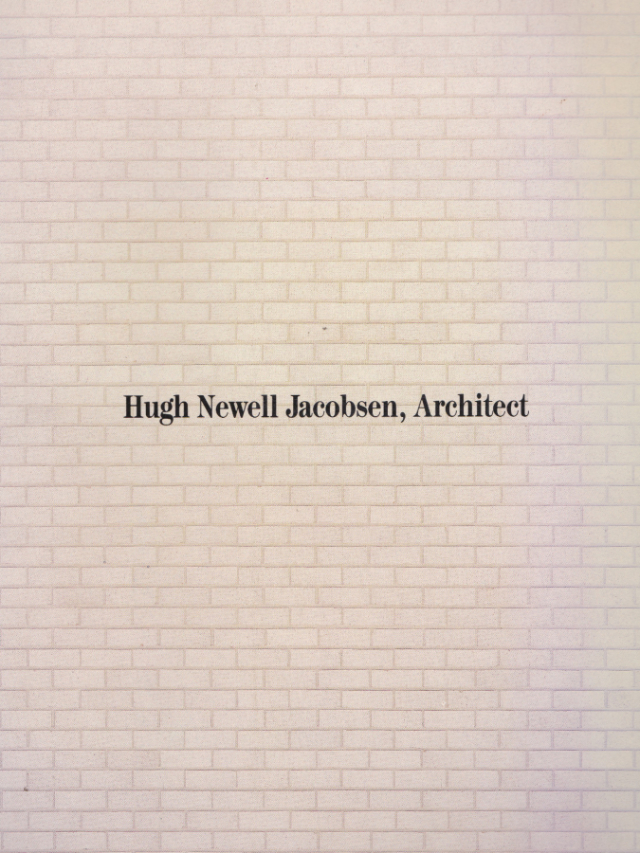Hugh Newell Jacobsen, Architect
Hugh Newell Jacobsen, ArchitectMassimo Vignelli (Editor)The American Institute of Architects Press, 1988Paperback | 9 x 12 inches | 352 pages | 400+ illustrations | English | ISBN: 978-0913962978PUBLISHER'S DESCRIPTION:This book documents the three-decade-long collaboration of one of America's finest architects and a great architectural photographer. Hugh Newell Jacobsen's projects, located in this country and abroad, have earned over 80 design awards, including six National Honor Awards from the American Institute of Architects. Robert Lautman's photographs of Jacobsen's work have been published regularly in Architecture, Architectural Record, House & Garden, and many other journals. This book, at last, celebrates their life's work together.A probing introduction by Vincent Scully traces the influences of Louis Kahn and Philip Johnson in Jacobsen's work and praises the "instinct for precision, clarity, and elegant formality" so evident in all his projects. Over 50 works are presented chronologically, including Bolton Square, the Renwick Gallery, Elliott House, the Arts and Industries Museum, Tidewater House, and Mendoza House—the National Award Winners. Descriptions and renderings of six current projects are also featured.Because, as Jacobsen writes, "the eloquence in the language of architecture is measured by how a building is put together," his famous construction details—hand-lettered by the architect—are reproduced in six full pages. Also included are a foreword by Massimo Vignelli, who designed the book, an illustrated biographical chronology, and a list of additional readings by and about Jacobsen.REFERRAL LINKS: dDAB COMMENTARY:On March 4, exactly one week shy of his 92nd birthday, American architect Hugh Newell Jacobsen died. Even in architecture school in the early 1990s, when firms like Morphosis and Coop Himmelb(l)au garnered most of my attention, I admired Jacobsen's buildings, especially the houses composed of pavilions capped by gable roofs. One could have lumped the DC-based architect into the postmodern camp (admittedly some of his house are very PoMo), but the pared down nature of the surfaces and spaces made his houses very modern for the most part. It was as if Modernism went down easier to his wealthy clients when it was wrapped in the traditional forms people visualized when thinking "home." Still, it took Jacobsen's passing for me to actually get one of his monographs, and the one I opted for was his first, published by the AIA Press in 1988 and edited and designed by Massimo Vignelli. It was actually the involvement of Vignelli, a designer I've long appreciated and written about on this blog, that made the first monograph more appealing than the two that followed. (A fourth monograph, on what is now the firm of Jacobsen Architecture, where his son Simon is the surviving partner, is set to be published by Rizzoli this fall.) Hugh Newell Jacobsen, Architect covers thirty years of the architect's practice, presenting more than forty completed buildings plus five projects in progress at the time of publication. At the front is a foreword by Vignelli and an introduction by Vincent Scully, while at the back are a glossary of oft-repeated construction details — including the famous eggcrate bookcases that appear to be in just about every one of his houses — and a chronology of all his projects between 1958 and 1988.Most of the completed buildings, not surprisingly, are houses, many of them in and around Washington, DC, and other parts of the East Coast. They are the raison d'être of Jacobsen's practice and the book's main attraction. I love poring over the floor plans provided for each house, seeing how they shifted from modern boxes to the so-called Monopoly houses he became known for and how the pavilion-like layouts actually work. Robert Lautman's photographs are very good and they provide some visual consistency that works well with Vignelli's layouts, but they would not have been enough to carry the book. Put another way, if you're an architect making a monograph, take a lesson from this one and always include floor plans, especially if your bread and butter is houses. Some favorite houses include, as presented in the book in chronological order: the Blumenthal House (spreads, below), which Vignelli singles out in his foreword as significant in forming Jacobsen's own architectural language; Three Linked Pavilions, a one-story house that navigates a 34-foot grade change via an expansive deck; the Buckwalter House, which appears to be Jacobsen's first Telescope house; the Huge (Hugh-Gee) House, a very modern plan with two linear bars on a dramatically sloped site; the Welles House, whose angled cross plan is aligned with the adjacent ruins of an early-20th-century trolley bridge; and the Bryan House, with its village-like plan and stone surfaces that echo an old church nearby. A half-dozen houses in a book with dozens more from the first half of a career that eventually spanned sixty ye

Massimo Vignelli (Editor)
The American Institute of Architects Press, 1988
Paperback | 9 x 12 inches | 352 pages | 400+ illustrations | English | ISBN: 978-0913962978
PUBLISHER'S DESCRIPTION:
REFERRAL LINKS:
SPREADS:







